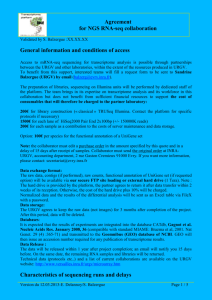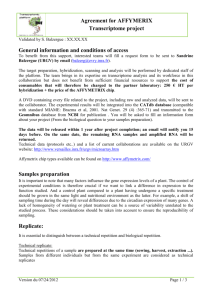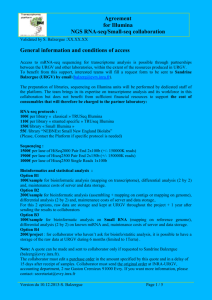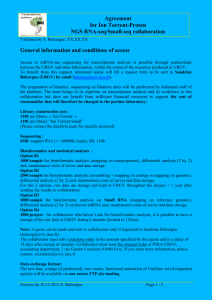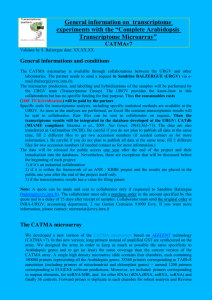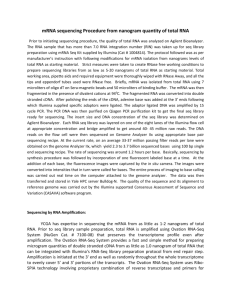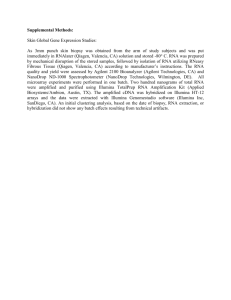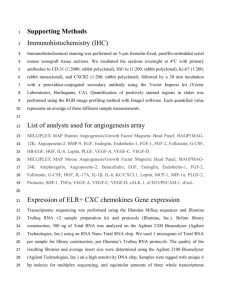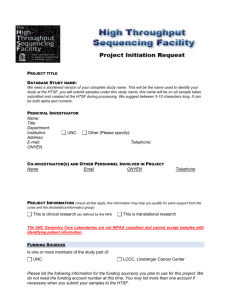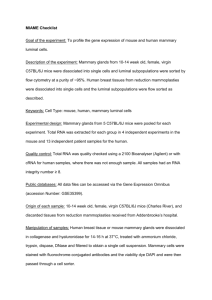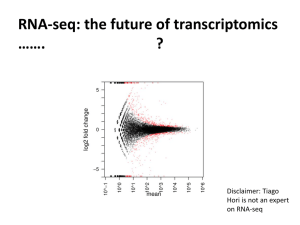Agreement-mRNA-seq + Small_Illlumina_2015 - URGV
advertisement
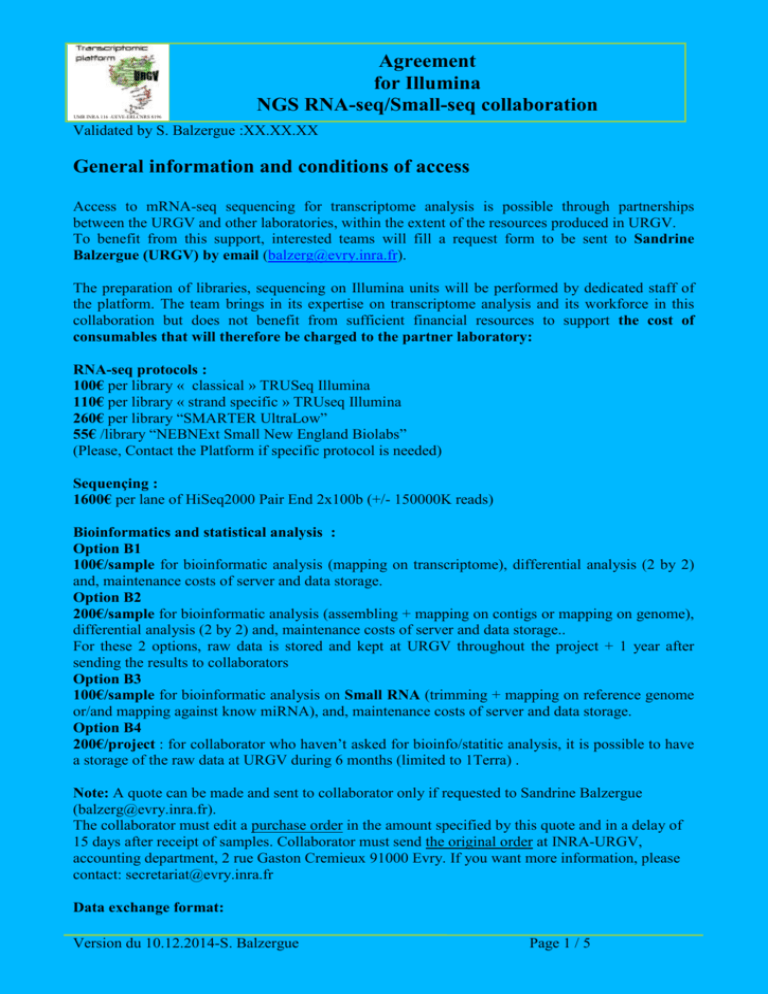
Agreement for Illumina NGS RNA-seq/Small-seq collaboration UMR INRA 116 -UEVE-ERLCNRS 8196 Validated by S. Balzergue :XX.XX.XX General information and conditions of access Access to mRNA-seq sequencing for transcriptome analysis is possible through partnerships between the URGV and other laboratories, within the extent of the resources produced in URGV. To benefit from this support, interested teams will fill a request form to be sent to Sandrine Balzergue (URGV) by email (balzerg@evry.inra.fr). The preparation of libraries, sequencing on Illumina units will be performed by dedicated staff of the platform. The team brings in its expertise on transcriptome analysis and its workforce in this collaboration but does not benefit from sufficient financial resources to support the cost of consumables that will therefore be charged to the partner laboratory: RNA-seq protocols : 100€ per library « classical » TRUSeq Illumina 110€ per library « strand specific » TRUseq Illumina 260€ per library “SMARTER UltraLow” 55€ /library “NEBNExt Small New England Biolabs” (Please, Contact the Platform if specific protocol is needed) Sequençing : 1600€ per lane of HiSeq2000 Pair End 2x100b (+/- 150000K reads) Bioinformatics and statistical analysis : Option B1 100€/sample for bioinformatic analysis (mapping on transcriptome), differential analysis (2 by 2) and, maintenance costs of server and data storage. Option B2 200€/sample for bioinformatic analysis (assembling + mapping on contigs or mapping on genome), differential analysis (2 by 2) and, maintenance costs of server and data storage.. For these 2 options, raw data is stored and kept at URGV throughout the project + 1 year after sending the results to collaborators Option B3 100€/sample for bioinformatic analysis on Small RNA (trimming + mapping on reference genome or/and mapping against know miRNA), and, maintenance costs of server and data storage. Option B4 200€/project : for collaborator who haven’t asked for bioinfo/statitic analysis, it is possible to have a storage of the raw data at URGV during 6 months (limited to 1Terra) . Note: A quote can be made and sent to collaborator only if requested to Sandrine Balzergue (balzerg@evry.inra.fr). The collaborator must edit a purchase order in the amount specified by this quote and in a delay of 15 days after receipt of samples. Collaborator must send the original order at INRA-URGV, accounting department, 2 rue Gaston Cremieux 91000 Evry. If you want more information, please contact: secretariat@evry.inra.fr Data exchange format: Version du 10.12.2014-S. Balzergue Page 1 / 5 Agreement for Illumina NGS RNA-seq/Small-seq collaboration UMR INRA 116 -UEVE-ERLCNRS 8196 Validated by S. Balzergue :XX.XX.XX The raw data, contigs (if performed), raw counts, functional annotation of UniGene set (if requested option) will be available via our secure FTP site loading. The collaborator agrees to repatriate the raw data on their own server maximum one month after the date of data availability. Normalized data and the results of the differential analysis will be sent as an Excel table via FileX with a password. Important: For collaborator who has not requested bioinfo / stats analyzes: the data will not be backed up URGV except if B4 option was taken. Upon request, the URGV platform can make a backup of the raw data (backup of FASTQ) for a time of 6 months (cost: 200 € / project). Data storage: The URGV agrees to keep the raw data (not images) for 1 year after completion of the project. After this period, data will be deleted. Databases: It is expected that the results of experiments are integrated into the database CATdb, Gagnot et al. Nucleic Acids Res. January 2008, 36 and Zaag et al. NAR 2015 (compatible with standard MIAME: Brazma et al, 2001. Nat Genet. 29 (4) :365-71) and transmitted to the Geomnibus (GEO) database of NCBI. GEO will then issue an accession number required for any publication of transcriptome results. Be careful if you do not plan to publish all data at the same time, fill 2 different files for two accession numbers (if needed contact us for more information.). Only projects that we carry out the analysis (normalization / differential analysis) will be submitted within two databases mentioned above. Data Release : The data will be released within 2 years after project completion; an email will notify you 15 days before. On the same date, the remaining RNA samples and libraries will be returned. Nevertheless, there are exceptions that will be discussed before the beginning of each project: 1) if it’s an industrial collaboration 2) if it is within the framework of an ANR / KBBE project and the results are placed in the public one year after the end of the project itself only. 3) if the transcriptomic results has a value for filing patent Technical data (protocols etc..) and a list of current collaborations are available on the URGV website: http://www.versailles.inra.fr/urgv/microarray.htm Characteristics of sequencing runs and delays The runs are performed on the Illumina sequencer HiSeq2000 via the CNS Genomics Institute in Evry. The number of reads per sample is adjusted according to your biological question. A phone call or a meeting at Evry to determine the aims and issues of the project and set up the experimental plan will systematically take place. This meeting should include the collaborator, the transcriptomics platform member and bioinformatics team of URGV. A second tripartite meeting will be scheduled upon receipt of sequences. Schedule: The estimated time to obtain sequencing data will be give to collaborator after good quality RNA reception on a platform. Depending on the options chosen for Bioinformatics analyzes a further period is required (two months in average). Version du 10.12.2014-S. Balzergue Page 2 / 5 Agreement for Illumina NGS RNA-seq/Small-seq collaboration UMR INRA 116 -UEVE-ERLCNRS 8196 Validated by S. Balzergue :XX.XX.XX These steps takes into account: - Construction of library - Sequencing - Analyses bioinformatics following option selected - Statistical analysis: normalization and differential analysis of data - Data Integration into CATdb and GEO (only for project that we carry out analysis) Samples preparation It is important to note that many factors influence the gene expression levels of a plant. The control of experimental conditions is therefore crucial if we want to link a difference in expression to the function studied. And a control plant compared to a plant having undergone a specific treatment should be grown in the same light and nutritional environment as the latter. For example, a shift of sampling time during the day will reveal differences due to the circadian expression of many genes. A lack of homogeneity of watering or plant treatment can be a source of variability unrelated to the studied process. These considerations should be taken into account to ensure the reproducibility of sampling. It is at the initiative of the collaborator to request the return of RNA samples sent to the platform. The platform will, however, keep the RNA 1 month after sending the results. Similarly, the sequencing libraries generated from RNA samples will be kept one month after sending the project results. The collaborator may request to send them back at any address. Replicates It is essential to distinguish between a technical repetition and biological repetition. Technical replicates: Technical repetitions of a sample are prepared at the same time (sowing, harvest, extraction ...). Samples from different individuals but from the same experiment are considered as technical replicates It allows the observation and quantification of technical bias (technical variability), the control of the reproducibility of the study and the quality control of the data but the results cannot be generalized. We also carry out the sequencing of biological replicates on different tracks. Biological replicates: Biological replicates samples are prepared in independent experiments (sowing, harvesting, extraction ...) with at least a 24 hours shift (beware of the circadian cycle). It allows the observation of inter-individual and inter-experiment variability. The results can then be generalized. It is necessary to provide at least one biological repetition, that is to say a repetition of the whole experiment. The aim is to characterize the biological variability between replicates, and "remove" it, to identify genes whose differential expression is related only to the studied factor. Quantity and quality needed for experiments Version du 10.12.2014-S. Balzergue Page 3 / 5 Agreement for Illumina NGS RNA-seq/Small-seq collaboration UMR INRA 116 -UEVE-ERLCNRS 8196 Validated by S. Balzergue :XX.XX.XX 4μg of total RNA (minimum concentration of 200ng/μl, contact the platform if you are not able to get this amount) per sample is expected. The purity of RNA is one of the most important factors for the success of the experiment, it is preferable to use an affinity purification protocol including the step of DNase I treatment (RNeasy kit Qiagen) For the sequencing of small RNA => We recommend to performed extractions with MIRVANA ™ miRNA Isolation Kit (Ambion), an amount of 2μg at 170ng/μl minium is required). For "difficult" samples such as seeds, the addition of PVP is very useful, contact us if needed. Total RNAs will be sent in dry ice in the elution solution. Their quality will be estimated on Agilent Chip and will be quantified with "RiboGreen" after arriving on the platform. Total RNA or Small RNA will be sent together with the fully completed information table (see and print the last page of this agreement). Process - Quality control of total RNA (Agilent Bioanalyzer) and quantification (RiboGreen). - Construction of libraries (RNA-seq, Small-RNA, RNA-seq-directional ...): Illumina protocols mainly - libraries Quality checking on Qbit et Agilent Bioanalyzer - Preparation of samples for sequencing (c-bot) - Sequencing on Illumina HiSeq2000 or Hiseq2500 - Assembly(if needed) - Contigs (if needed) - Mapping - Counting - Standardization with TMM - Differential Analysis (EdgeR) After statistical analysis of raw results, for each comparison, a list of genes is produced as an Excel file. It includes the average count of condition #1, the average count of condition #2, the ratio, a raw and adjusted p-value to allow control of false positives. Results publication This is a project involving the collaborating scientists and the URGV, in which the platform brings in its expertise. Only the cost of consumables is supported by the partner laboratory. - A member of the transcriptomics Platform and a member of "Genomics and Predictive Bioinformatics" of URGV will be co-authors of the first publication in which transcriptome data will be presented. The same convention will be applied to the filing of Patent on the initiative of the employee and in which the transcriptome results will be used. You will also be asked to include in the description of the data, the CATdb database (example: "All raw and normalized data are available-through the database CATdb (AU_XXXXXXX, Gagnot et al, 2008 and Zaag et al. NAR 2015) and from the Gene Expression omnibus (GEO) repository at the National Center for Biotechnology Information (NCBI) (T. Barrett et al. NAR 2006): GSE accession number XXXXX. Version du 10.12.2014-S. Balzergue Page 4 / 5 Agreement for Illumina NGS RNA-seq/Small-seq collaboration UMR INRA 116 -UEVE-ERLCNRS 8196 Validated by S. Balzergue :XX.XX.XX Project Design (required): We ask you to provide the following information: 1 - Title of Project 2 - Name and address of project manager 3 - Name and address of the person responsible for monitoring the analysis in relationship with URGV 4 - Scientific aims (be as accurate as possible including :) Biological question? Annotation, RNA quantification / Small-RNA, construction of High Density chip? …. 5 – Experiment Design including: Number of reads per sample: Type of library: Sequencing machine: Multiplexed sample (how?): Sequencing: Pair End Sequencing length: 100bp, Does a reference genome or UniGene (transcriptome) set exist?: yes / no … 6 - Number of libraries - description of samples per run (organ, stage of sampling according to Boyes et al. Plant Cell 2001, treatment ...)– 7 - Expected date of delivery of samples to URGV Signature: Experimental laboratory(URGV) Collaborator -----------------------------------------------------------------------------------------------------------------------8 – Table to join to the RNA samples when sending: TUBE name Sample name experimental design Version du 10.12.2014-S. Balzergue on Concentration µg/µl RNA extraction method? DNAseI? Page 5 / 5
